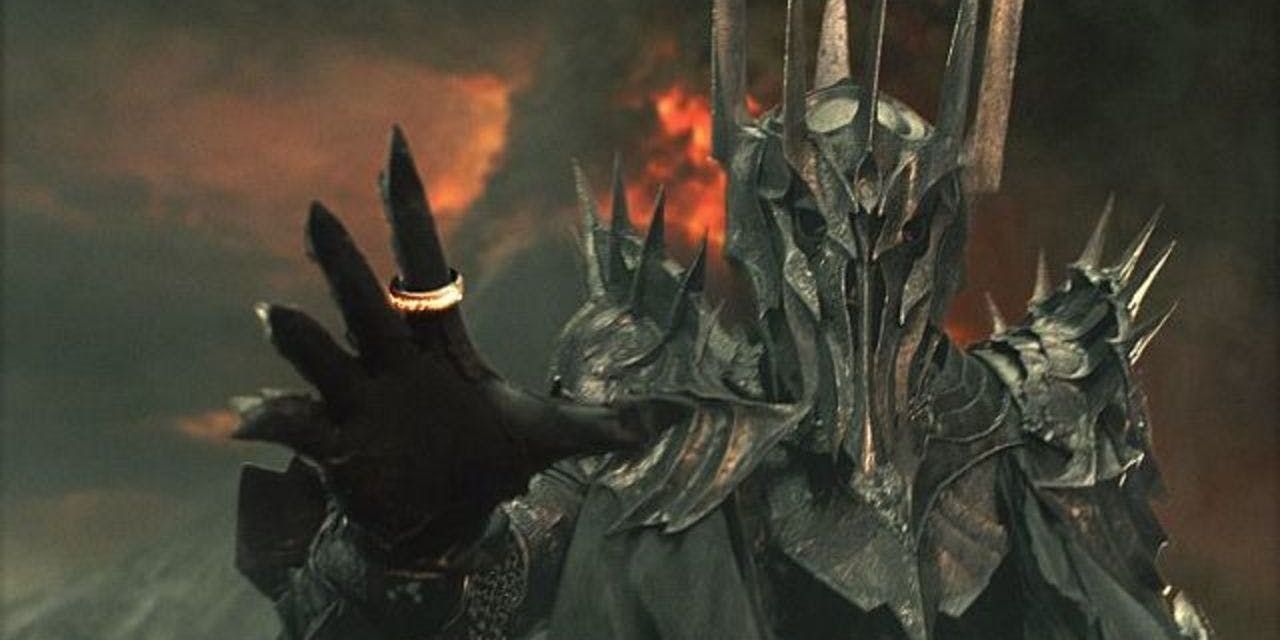
The prologue of Peter Jackson’s The Lord of the Rings: The Fellowship of the Ring portrayed the War of the Last Alliance, which ended the Second Age of Middle-earth. Things were looking dire for the Last Alliance of Elves and Men. The Dark Lord Sauron killed King Elendil, and he had Elendil’s son, Isildur, dead to rights. But as he reached towards Isildur to deliver the killing blow, Isildur used his father’s shattered sword to slice the One Ring from Sauron’s outstretched hand. Since the One Ring was the source of the Dark Lord’s power, its removal destroyed his body, leaving behind nothing but ash and empty armor.
Sauron was an immortal spirit known as a Maia, so this did not truly kill him. However, he had to spend over a thousand years recovering from this humiliating defeat and recreating a physical form. Reaching his hand towards Isildur was a monumentally poor choice on Sauron’s part. He had no shortage of ways to kill his enemies, such as battering them with his enormous mace or crushing them beneath his metal boot, so why did he attempt to vanquish Isildur in a way that exposed his greatest weakness?
Sauron Wanted to Make a Show of Isildur’s Death

Sauron’s defeat differed in J. R. R. Tolkien’s The Lord of the Rings novel; there, Isildur did not cut the One Ring from Sauron’s finger until the Dark Lord had already been defeated in battle.
The answer to this question may lie in a deleted scene from The Fellowship of the Ring. Originally, the prologue was going to include a shot of Sauron killing High King Gil-galad, the leader of the Elves. He would have done so by holding Gil-galad by the throat and burning him to death with the heat emanating from his magical hands. This detail did come from Tolkien’s novel; the chapter “The Council of Elrond” revealed that “the heat of Sauron’s hand, which was black and yet burned like fire,” killed Gil-galad.
Sauron likely wanted to do the same to Isildur. This was far from the most efficient method of eliminating his adversaries, but it was flashy. Sauron wanted to crush the Last Alliance’s final hope with an impressive display of his overwhelming power. Incinerating Isildur with his fiery grasp would have terrified his opponents, bolstered his minions, and perhaps most importantly, satisfied his sadism. Despite his delusions of grandeur, Sauron was cruel beyond measure and enjoyed inflicting pain on those who stood against him.
Sauron Did Not Learn From His Mistakes








Knowing this does not change the fact that Sauron took a major and unnecessary risk by reaching towards Isildur, but that ties into an overarching theme of The Lord of the Rings. Though Middle-earth’s villains were extremely intelligent, they also made extremely foolish oversights. They became blinded by their negative traits, such as arrogance, greed, and bloodlust, and this was their undoing. For example, the Witch-king of Angmar continued to torment King Théoden even after delivering a fatal blow, which led to his duel with the woman who was destined to slay him. Likewise, Saruman repeatedly abused Gríma Wormtongue, which prompted his formerly submissive servant to stab him in the back. Sauron toying with his prey during the War of the Last Alliance followed this self-destructive pattern. Sauron’s hubris was apparent in the Third Age as well. He did make some adjustments to his strategy following the War of the Last Alliance. For instance, during the War of the Ring, he remained in his tower of Barad-dûr instead of joining his minions on the battlefield. However, he did not correct the underlying flaws that led him to make such a catastrophic error; he remained overconfident and narrow-minded. Sauron could have guarded Mount Doom — it only would have taken a few Orcs stationed outside the Crack of Doom to stop Frodo and Sam in their tracks — but it never occurred to him that someone would attempt to destroy the One Ring. He assumed that anyone who came into possession of the Ring would use it to become a conqueror like himself. Just as in the Second Age, an easily avoidable mistake brought about his downfall.




